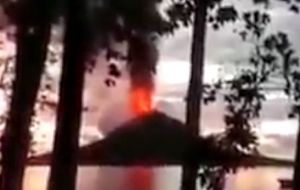MercoPress. South Atlantic News Agency
Volcano erupts, tsunami kills at least 222 in Indonesia - more tremors not ruled out
 Video footage on social media of the volcano's eruption.
Video footage on social media of the volcano's eruption. A tsunami in Indonesia after the eruption of the Anak Krakatau Volcano killed at keast 222 people, while hundrerds more were reported either injured or missing, local authorities explained Sunday. They were cautious, though, since these are just preliminary figures.
A spokesman for the national disaster agency said 843 people were injured and 28 were missing, as of 4pm local time. “This number will continue to rise, considering not all places have been checked,” Dr Sutopo Purwo told a media briefing in Yogyakarta.
He added that the tsunami was likely caused by “an undersea landslide resulting from volcanic activity on Anak Krakatau” and was exacerbated by an abnormally high tide because of the current full moon. But he said there were no “significant” seismic tremors to indicate a tsunami was coming and various agencies were still trying to determine the actual cause. Coastal residents reported not seeing or feeling any warning signs, such as receding water or an earthquake, before waves of 2-3 metres washed ashore, according to media. Authorities said a warning siren went off in some areas.
“The tsunami hit several areas of the Sunda Strait, including beaches in Pandeglang regency, Serang, and South Lampung,” the spokesman also explained.
The Meteorology, Climatology and Geophysics Agency (BMKG) said the tsunami was detected at four locations in the provinces of Banten and Lampung at 9.27pm local time on Saturday.
Mr Rahmat Triyono, the head of the BMKG's earthquake and tsunami department, said in a brief press conference that more tsunamis were possible “as long as there is increased activity of the Anak Krakatau volcano“.
“If there is increased activity, then we have to raise the alert,” he said, adding that the agency was awaiting an assessment from Indonesia’s Geological Agency.
BMKG chief Dwikorita Karnawati warned residents and tourists in coastal areas around the Sunda Strait to stay away from beaches until Tuesday (Dec 25). Residents and hotels in those areas have also been told to refrain from holding beach activities.
President Joko Widodo said on Twitter that he had “ordered all relevant government agencies to immediately take emergency response steps, find victims and care for the injured”.
Mr Rahmat said the authorities were initially unsure whether the waves were caused by a tsunami. Saturday's tsunami was different from an earthquake-spawned tsunami, which is usually followed by aftershocks of a lower magnitude. Hence, the chances of a follow-up tsunami are low. “Saturday's tsunami was triggered by eruptions. Volcano eruptions can be small in the beginning and big later on,” he said.
However, Mr Rudi Suhendar, the head of Indonesia's Geological Agency said he still could not rule out that bad weather, rather than an eruption, had caused the tidal surge, as the volcano had been active since the end of June and the amplitude of Saturday's eruption was not the biggest.




Top Comments
Disclaimer & comment rulesCommenting for this story is now closed.
If you have a Facebook account, become a fan and comment on our Facebook Page!